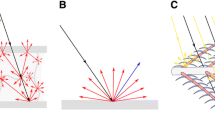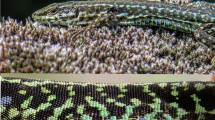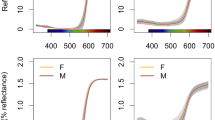Abstract
The glossy sheen of healthy hair is an ideal of human beauty; however, glossiness has never been quantified in the context of non-human animal signaling. Glossiness, the specular reflectance characteristic of polished surfaces, has the potential to act as a signal of quality because it depends upon material integrity and cleanliness. Here, we undertook two studies of glossiness in avian plumage to determine (a) the repeatability of a recently developed measure of glossiness, (b) the relationship between glossiness and conventional measures of coloration, and (c) how glossiness is associated with quality signaling. Using museum specimens of three North American bird species with glossy plumage (red-winged blackbird, Agelaius phoeniceus; great-tailed grackle, Quiscalus mexicanus; Chihuahuan raven, Corvus cryptoleucus), we found that the glossiness measure was highly repeatable for all species and was significantly correlated with plumage coloration (e.g., chroma, brightness) in male great-tailed grackles. We then used wild-caught grackles to examine sexual dimorphism in plumage glossiness and its correlation to a potentially sexually selected trait in this species, male tail length. We found that males were significantly glossier than females and that male, but not female, glossiness correlated positively with tail length. This study provides a repeatable method to measure glossiness and highlights its potential as a signal of individual quality in animals.



Similar content being viewed by others
References
Abramoff MD, Magelhaes PJ, Ram SJ (2004) Image processing with ImageJ. Biophotonics Int 11:36–42
Andersson M (1994) Sexual Selection. Princeton University Press, Princeton
Andersson S, Prager M (2006) Quantifying Colors. In: Hill GE, McGraw KJ (eds) Bird coloration. Volume 1: mechanisms and measurements. Harvard University Press, Cambridge, pp 41–89
Bednarz JC, Raitt RJ (2002) Chihuahuan raven (Corvus cryptoleucus). In: Poole A (ed) The birds of North America online. Cornell Lab of Ornithology, Ithaca
Bennett ATD, Cuthill IC, Norris KC (1994) Sexual selection and the mismeasure of color. Am Nat 144:848–860
Björklund M (1991) Evolution, phylogeny, sexual dimorphism and mating system in the grackles (Quiscalus spp.: Icterinae). Evolution 45:608–621
Bonier F, Martin PR, Sheldon KS, Jensen JP, Foltz SL, Wingfield JC (2007) Sex-specific consequences of life in the city. Behav Ecol 18:121–129
Doucet SM, Shawkey MD, Hill GE, Montgomerie R (2006) Iridescent plumage in satin bowerbirds: structure, mechanisms and nanostructural predictors of individual variation in colour. J Exp Biol 209:380–390
Endler JA, Mielke PW (2005) Comparing entire colour patterns as birds see them. Biol J Linn Soc 86:405–431
Fokidis HB, Greiner EC, Deviche P (2008) Interspecific variation in avian blood parasites and haematology associated with urbanization in a desert habitat. J Avian Biol 39:300–310
Gangestad SW, Scheyd GJ (2005) The evolution of human physical attractiveness. Annu Rev Anthropol 34:523–548
Geisler WS (2008) Visual perception and the statistical properties of natural scenes. Annu Rev Psychol 59:167–192
Hegedüs R, Szél G, Horváth G (2006) Imaging polarimetry of the circularly polarizing cuticle of scarab beetles (Coleoptera: Rutelidae, Cetoniidae). Vis Res 46:2786–2797
Jaramillo A, Burke P (1999) New world blackbirds: the icterids. Princeton University Press, Princeton
Johnson K, Peer BD (2001) Great-tailed grackle (Quiscalus mexicanus). In: Poole A (ed) The birds of North America online. Cornell Lab of Ornithology, Ithaca
Johnson K, DuVal E, Kielt M, Hughes C (2000) Male mating strategies and the mating system of great-tailed grackles. Behav Ecol 11:132–141
Kemp DJ, Macedonia JM (2006) Structural ultraviolet ornamentation in the butterfly Hypolimnas bolina L. (Nymphalidae): visual, morphological and ecological properties. Aust J Zool 54:235–244
Kirkpatrick CE, Robinson SK, Kitron UD (1991) Phenotypic correlates of blood parasitism in the common grackle. In: Loye JE, Zuk M (eds) Bird–parasite interactions. Oxford Univ Press, New York, pp 344–358
Landy MS (2007) Visual perception—a gloss on surface properties. Nature 447:158–159
Lessells CM, Boag PT (1987) Unrepeatable repeatabilities: a common mistake. Auk 104:116–121
McMullen R, Jachowicz J (2003) Optical properties of hair: effect of treatments on luster as quantified by image analysis. J Soc Cosmet Chem 54:335–351
McNett GD, Marchetti K (2005) Ultraviolet degradation in carotenoid patches: live versus museum specimens of wood warblers (Parulidae). Auk 122:793–802
Meadows MG, Butler MW, Morehouse NI, Taylor LA, Toomey MB, McGraw KJ, Rutowski RL (2009) Iridescence: views from many angles. J R Soc Interface 6:S107–S113
Montgomerie R (2006) Analyzing Colors. In: Hill GE, McGraw KJ (eds) Bird coloration Volume 1: mechanisms and measurements. Harvard University Press, Cambridge, pp 90–147
Montgomerie R (2008) CLR, version 1.05. Queen’s University, Kingston, Canada. http://post.queensu.ca/∼mont/color/analyze.html. Accessed 2 Dec 2008)
Motoyoshi I, Nishida S, Sharan L, Adelson EH (2007) Image statistics and the perception of surface qualities. Nature 447:206–209
Rasmussen PV, Dyck J (2000) Silkiness in brown mink pelts characterized with optical methods. J Anim Sci 78:1697–1709
Ruxton GD, Sherratt TN, Speed MP (2004) Avoiding attack: the evolutionary ecology of crypsis, warning signals, and mimicry. Oxford Univ Press, New York
Sandilands V, Powell K, Keeling L, Savory CJ (2004) Preen gland function in layer fowls: factors affecting preen oil fatty acid composition. Br Poult Sci 45:109–115
Sharan L, Li Y, Motoyoshi I, Nishida S, Adelson EH (2008) Image statistics for surface reflectance perception. J Opt Soc Am A 25:846–865
Shawkey MD, Pillai SR, Hill GE (2003) Chemical warfare? Effects of uropygial oil on feather-degrading bacteria. J Avian Biol 34:345–349
Shawkey MD, Hauber ME, Estep LK, Hill GE (2006) Evolutionary transitions and mechanisms of matte and iridescent plumage coloration in grackles and allies (Icteridae). J R Soc Interface 3:777–786
Stamm RF, Garcia ML, Fuchs JJ (1977) Optical-properties of human hair. 2. Luster of hair fibers. J Soc Cosmet Chem 28:601–609
Stevens M, Parraga CA, Cuthill IC, Partridge JC, Troscianko TS (2007) Using digital photography to study animal coloration. Biol J Linn Soc 90:211–237
Surmacki A, Nowakowski JK (2007) Soil and preen waxes influence the expression of carotenoid-based plumage coloration. Naturwissenschaften 94:829–835
Vleck CM, Vertalino N, Vleck D, Bucher TL (2000) Stress, corticosterone, and heterophil to lymphocyte ratios in free-living Adélie penguins. Condor 102:392–400
Vorobyev M, Osorio D, Bennett ATD, Marshall NJ, Cuthill IC (1998) Tetrachromacy, oil droplets and bird plumage colours. J Comp Physiol A 183:621–633
Webster MS (1992) Sexual dimorphism, mating system and body size in new world blackbirds (Icterinae). Evolution 46:1621–1641
Yasukawa K, Searcy WA (1995) Red-winged blackbird (Agelaius phoeniceus). In: Poole A (ed) The birds of North America online. Cornell Lab of Ornithology, Ithaca
Yonehara M, Matsui T, Kihara K, Isono H, Kijima A, Sugibayashi T (2004) Experimental relationships between surface roughness, glossiness and color of chromatic colored metals. Mater Trans 45:1027–1032
Zampiga E, Hoi H, Pilastro A (2004) Preening, plumage reflectance and female choice in budgerigars. Ethol Ecol Evol 16:339–349
Acknowledgements
All work was performed under Arizona State University Animal Care and Use protocol 05-764R, United States Fish and Wildlife Service permit #MB088806-0, and Arizona State Game and Fish scientific collecting permit SP797514. We thank Katherine Butler, Mimi Kessler, Caroline Mead, ASU DACT, and Tempe Gordon Biersch for their help with grackle capture. We thank Dr. Christopher Witt, Andrew Johnson, and the Museum of Southwestern Biology at the University of New Mexico, Albuquerque, for access to study skins. We thank Dr. Martin Stevens and Dr. Isamu Motoyoshi for advice on image analysis and two anonymous reviewers whose comments and suggestions improved our manuscript. This research was supported by funding from the College of Liberal Arts and Sciences and the School of Life Science at Arizona State University (to K. J. M.). M. G. M. and L. A. T. were supported by National Science Foundation Graduate Research Fellowships during the preparation of this manuscript.
Author information
Authors and Affiliations
Corresponding author
Additional information
Communicated by S. Pruett-Jones
Rights and permissions
About this article
Cite this article
Toomey, M.B., Butler, M.W., Meadows, M.G. et al. A novel method for quantifying the glossiness of animals. Behav Ecol Sociobiol 64, 1047–1055 (2010). https://doi.org/10.1007/s00265-010-0926-z
Received:
Revised:
Accepted:
Published:
Issue Date:
DOI: https://doi.org/10.1007/s00265-010-0926-z




